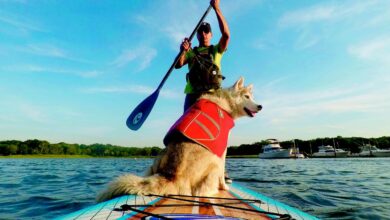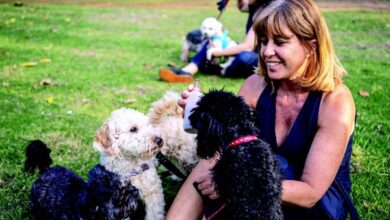How to Care for a Blind Dog – Dogster

[ad_1]
The idea of caring for a blind dog can be intimidating: What special care needs to be taken? Is it possible to treat him as a normal dog? Are there extra financial stresses with the care of a blind dog?
The care for a blind dog shouldn’t be any more imposing than that of a regular dog, says Paula Biancone, Director of Animal Welfare for Speak for the Unspoken, a nonprofit group based in Ohio, dedicated to caring for dogs with special needs.
“Blind dogs, especially those who are born blind, have no idea they are blind,” says Paula. “They act just like any other puppy or dog, just with extra navigation skills.”
Being unable to see is typically the only handicap a blind dog will have. Blind dogs can still play, run, find food, jump up on the sofa, crawl onto a dog bed, go on hikes and walks … basically anything a normal dog can do, they can do. “The only thing they can’t do is see,” Paula says.
Paula stresses that training a blind dog should be no different than training a dog or puppy who can see. Leash training works the same way as standard manners training — relying more on your voice, instead of any hand motions. Walk your blind dog leashed like you would any other dog.
Living with a blind dog
Blind dogs do what is called “mapping” when they are introduced to a new space. Puppies do the same when they start to stand and explore at around two weeks old. Paula explains that mapping is a lot like what a robotic sweeper does when it’s getting the layout of your home and the rooms it will be working in. The dog will walk, or “map,” the perimeter of the space along the walls, then around the objects in the area (couch, tables, chairs, etc.) until he has mapped out the entire space. This process is repeated a few more times until the dog can remember the layout of the space.
“If something is new in the space, or if something moves, the dog will just repeat the mapping in the area of that newly-introduced object,” says Paula. Mapping isn’t just limited to small rooms, but to the entire house and yards.
“After many years of caring and fostering blind dogs, we have found that no special gear is needed,” says Paula. “Since blind dogs have their hearing, training is the same as any other dog — you can use verbal-only commands, or verbal and touch commands for training.”
To let others know your dog is seeing impaired, your dog can wear a bandana, harness and or even collar tag that tells other people he is blind, so they know to address him through voice cues and touch. This is especially important if he somehow becomes lost.
[ad_2]
Source link






